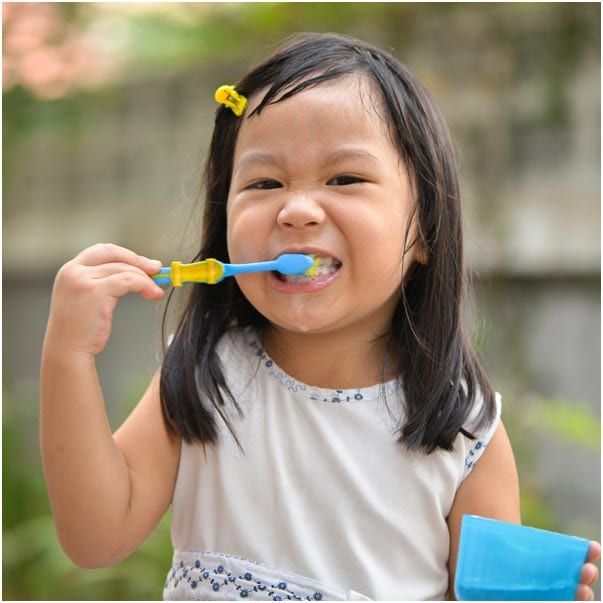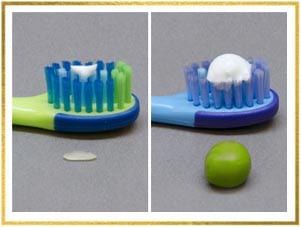If you’re feeling confused about how and when to start brushing your baby’s teeth, you’re not alone. We get asked questions on this topic all the time! Some popular ones are: Should I be brushing my baby’s teeth if they only have a couple? What kind of toothbrush or toothpaste should I use? How can I make sure I’m doing a good job brushing if my baby is so squirmy?
What we know for sure is, when brushing and flossing teeth are part of the routine from early on, children are set up for a lifetime of optimal oral health. To give you some tools to keep your kiddo’s teeth clean and healthy from the start, we are covering when and how to begin brushing your baby’s teeth.
When to start brushing
Even before the first tooth sprouts, you can begin your baby’s oral hygiene routine. Studies show that cavity causing bacteria can grow on your baby’s tongue long before teeth are in the mouth. So, why not get a head start! It’s a good practice to wipe your little one’s gums and tongue after feedings. To do so, dampen a washcloth and wrap it around your index finger. Next, gently wipe and cleanse your baby’s gums and tongue. Once the first tooth makes its debut, it’s time to roll out the toothbrush and brush twice a day. Add flossing to the nighttime routine if any two baby teeth are touching.
How to brush
To start, grab a soft bristled baby toothbrush. Next up, you’ll need fluoride toothpaste with a kid-approved flavor. We recommend using fluoride toothpaste from the start since brand new teeth are like sponges and can soak up the fluoride in the paste. This makes the enamel stronger for the lifetime of those teeth. Use only a smear or a rice-sized amount on the toothbrush. At 3, you’ll increase the amount to a pea size.
Every morning and night, brush all surfaces of the teeth, moving the brush in a circular motion for two minutes. Use a clean index finger to move their cheeks and lips out of the way to improve your visibility and access to their teeth. Finally, don’t forget to brush their tongue, which can house bacteria that cause bad breath.
Seems easy enough, right? Well, it can be, especially early on when your baby is less mobile. Brushing can become a little harder in the toddler years when they begin to assert their independence and want to brush on their own. We like to encourage toddlers to share the job of brushing with their grown-ups. That way, everyone wins. They get their turn to brush by themselves and you can make sure it’s a job well done. As a rule of thumb, until children have the manual dexterity to tie their own shoes, they need help from an adult to brush their teeth. For many kids, that could be around 6 years old. Good news is there are many ways to make brushing fun.
So, how exactly do we get the job done on a squirmy baby or resistant toddler? Positioning is key. When you are stationed behind your baby or toddler, you are mimicking the posture you use to brush your own teeth, so it should feel natural to you. You’ll also get a much better view of your child’s teeth than if you were in front. Now, let’s get down to a few specific positioning techniques:
- Laying down approach: 1 – 2 person technique, best for ages 6 mo – 2.5 years
Lay your baby or toddler down on their back on a bed. Sit on your knees behind them, placing their head in your lap. You can stabilize their wobbly head between your thighs and if another person is around, they can hold your child’s hands and distract them with songs or stories as you brush.
- Knee to knee approach: 2 person technique, best for ages 6 mo – 2.5 years
Sitting face to face with another adult and with your knees touching theirs, you create a flat surface with your thighs onto which you will lay your child down. With your kiddo’s legs straddling one adult, lay them back into the brusher’s lap. This technique works particularly well for a resistant child since it gives you more control. We often position this way at your child’s first few dental visits, so practicing this at home will help make those appointments a breeze!
- Standing approach: 1 person technique, best for ages 2.5+
Once your child is ready to be more hands on with brushing, standing is the way to go. Coming from behind, use one hand to cradle their head and the other to brush. Have them tilt their head back for a better view of their teeth. Once you’re done, let them have that turn they’ve been waiting for!
Here are some great videos demonstrating some of these techniques:
- How to Brush a One Year Old’s Teeth
- How to Brush a Two Year Old’s Teeth
- How to Brush a Three Year Old’s Teeth
No matter the approach, there will be good days and bad days with brushing. Still, we always encourage you to keep at it, even when the going gets tough. In doing so, you will teach your child that brushing is an important part of everyday life. With a little time and some creative ways to make brushing fun, you’re little one is sure to enjoy the ritual. And of course, we’re always here to help. Visit us at Sunshine Smiles, and we’ll work with you to keep your child’s smiles healthy and bright!




